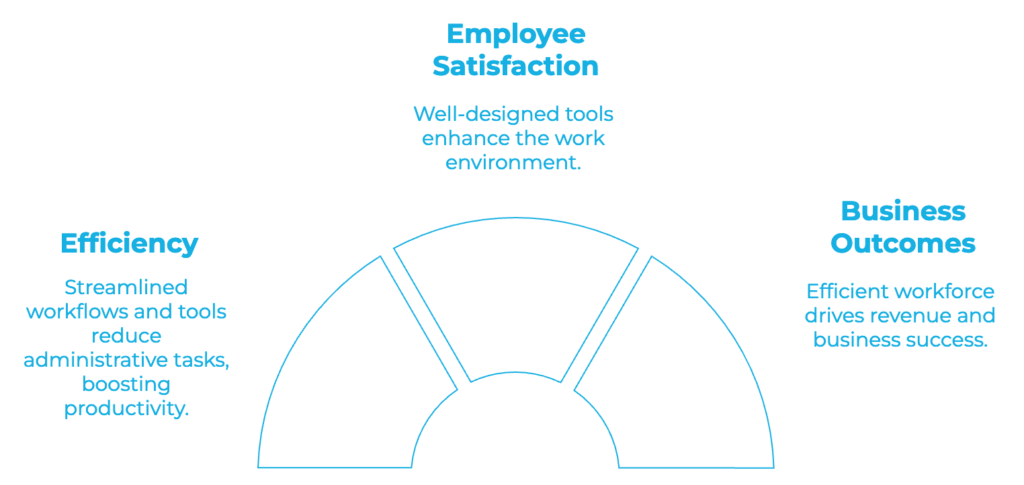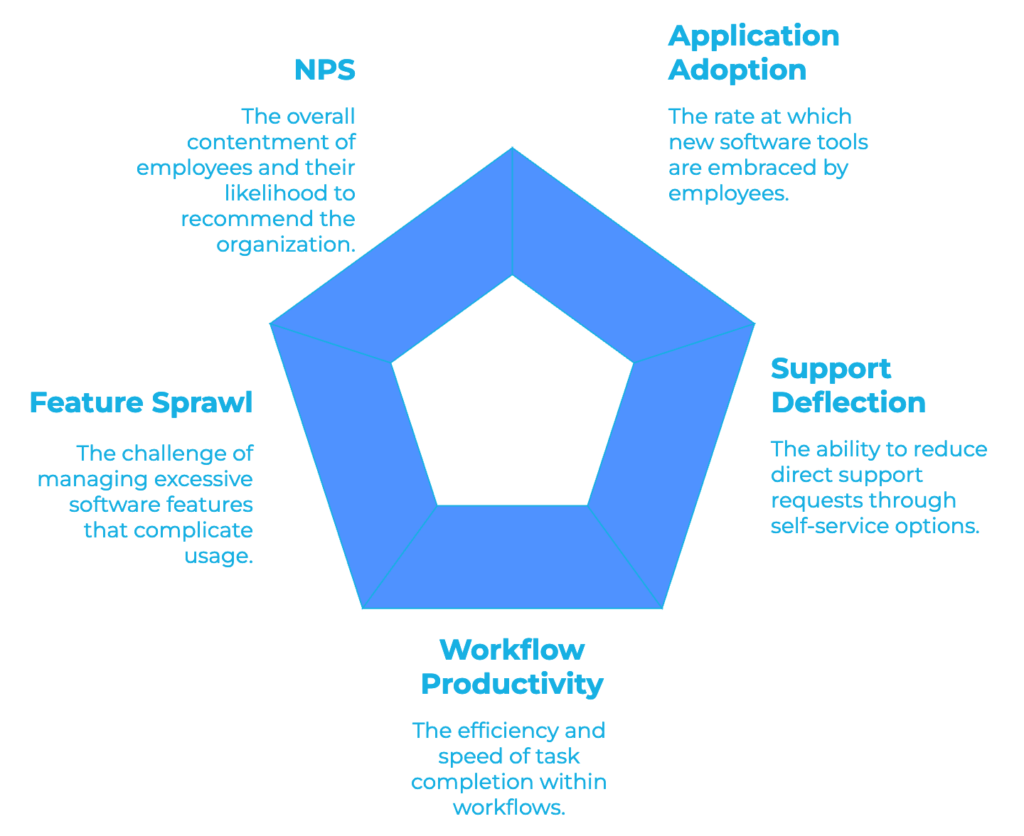An often overlooked role in product management is the internal product manager. As organisations become more dependent on internal teams, this role is becoming more and more important as companies look to rely more on operations and productivity within engineering teams.
In most organisations, this role usually involves maintaining and improving tools for employees, of tools used by employees across various departments.
These tools could range from human resource management systems to developer tools. The primary objective is to improve workflows, minimize inefficiencies, and ultimately contribute to the overall success of the company.
In this guide, we look at the fundamentals of internal product management, the biggest challenges, and some metrics that you can track.
Over the past 10 years or so, organisations have increasingly found that employee tools are important to improve customer-facing products. Poorly designed internal products can hinder employee productivity, cause frustration, and negatively affect the company's performance. It. Gradually, business leaders have found value in creating well-designed internal tools that lead to streamlined workflows, faster decision-making, and a more satisfied workforce.
With the rise of tech-heavy infrastructures, businesses now require internal teams to operate at a much faster rate. This growth in the technology space has led to a bigger emphasis on the role of internal product managers, who are responsible for ensuring that these tools are not only functional but also aligned with business goals.
A few months ago, spoke to Lambros Charissis, Group Product Manager, Platform Engineering at Wise, who explained how “Internal product management is not just about creating software—it’s about solving problems and enabling employees to do their jobs better.”
Below are some key areas in which internal product managers make an impact:

Increase Efficiency: Streamlined workflows and easy-to-use tools reduce the time employees spend on administrative tasks, allowing them to focus on high-value activities.
Enhance Employee Satisfaction: Just as poor customer experiences can lead to churn, bad internal tools can cause employee dissatisfaction. Well-designed internal tools contribute to a positive work environment.
Drive Business Outcomes: Ultimately, the goal of internal product management is to create a more efficient and effective workforce, which in turn drives revenue and business success.
The key roles of internal product teams vary. However, while both external and internal product teams endeavour to solve customer pain points, internal product managers are usually more technical, as they focus on building internal tools for technical teams. Their responsibilities include:
Identifying employee needs: Internal product managers regularly work with various departments to understand the pain points internal teams face when using current tools or systems.
Product development: Once needs are identified, internal product managers work closely with development teams to design and build tools that meet those needs. This process involves prioritising features, creating user stories, and managing backlogs.
Continuous feedback and improvement: Internal product teams continually monitor usage, gather feedback, and make iterative improvements to ensure the tool remains effective.
Alignment with business goals: Internal products support the company's larger objectives, whether that's improving efficiency, cutting costs, or fostering collaboration across teams.
Below are also the key differences between internal and external product managers.
Users interactions
As Lambros notes in his feature on Mind the Product, internal users are more accessible and captive, without the concern of losing them to competitors, as Lambros points out. This, however, does not mean they shouldn’t be treated as customers.
Team structure and support
Internal product teams also typically report to the CTO rather than the CPO due to them being more technical and working more closely with the engineering team.
Resources and signposting
In most cases, internal product teams have to advocate for their own feature or product launch. Many companies have limited marketing or sales resources, so it’s usually up to internal product managers to advocate for themselves to increase visibility.
Product-market fit
Connecting internal product work to business goals can often be indirect compared to connecting it to an external product manager. The goal of an internal product team is straightforward compared to the ever-changing goalposts of an external product team.
Key metrics for internal product managers
Like any other role, the success of internal product managers can be measured by key metrics. These KPIs help track whether the internal tools are meeting their objectives and improving employee efficiency. Here are some essential metrics every internal product manager should consider tracking:

1. Application Adoption
One of the first indicators of success for any internal product is adoption. Are employees actually using the tool? Adoption rates can be tracked through several metrics:
Monthly Active Users (MAU)
Weekly Active Users (WAU)
Daily Active Users (DAU)
Tracking this can indicate whether employees find the tool valuable. A low adoption rate might show problems with usability, lack of awareness, or insufficient training.
2. Support Deflection
Another key measure of how successful an internal product performs is how well it reduces the need for manual support. Support deflection refers to the degree to which an internal tool can reduce support tickets, or IT help requests by providing employees with self-service capabilities.
For example, internal tools can include embedded help centres, FAQs, or even AI-driven chatbots that guide users through common issues. The fewer support tickets employees need to open, the more self-sufficient they become, freeing up IT resources for critical tasks.
3. Workflow Productivity
A core goal of internal product management is to improve workflow productivity. This metric can track how efficiently employees can complete key tasks by using a new tool or feature launched by the internal product team.
If a tool, for example, is designed to automate expense reporting, workflow productivity would be measured by how much time employees save compared to the previous manual process. The faster and more accurately employees can complete critical tasks, the more valuable the tool becomes.
4. Feature Sprawl
As internal tools evolve over time, they tend to accumulate too many features. Feature sprawl occurs when a product becomes inflated with rarely used or unnecessary features, making it harder for employees to navigate and use effectively.
To deal with feature sprawl, internal product managers must regularly look at which features are being used and which aren’t. By sunsetting unused features, they can streamline the product, improving the overall experience for internal teams.
5. Employee Satisfaction and Net Promoter Score (NPS)
Employee satisfaction with internal tools can be measured through surveys and feedback. A popular method for gauging satisfaction is the Net Promoter Score (NPS), which asks employees how likely they are to recommend a given tool to a colleague.
This metric can be useful for providing a clear understanding of how internal users are engaging with a product.
Above, we’ve explained how internal product management differs from external customer-facing product roles. We’ve highlighted some key areas of best practice so you can set yourself in a good position for success:
1. Treat Internal products like external products
Just because internal tools are not external customer-facing, they should still be treated with the same level of care and attention. Internal product teams should aim to always speak to users and iterate on the product to ensure it meets employee needs.
2. Prioritise the User Experience
Employee productivity can be affected by how easy or difficult a tool is to use. Internal product teams should focus on the user experience when launching new tools or features to ensure that they are easy to navigate.
3. Use data
Data is important in any product role, but internal product teams can gain valuable insights by understanding how employees use internal tools. For example, figuring out what tools are well engaged with, and others with a high drop-off rate.
4. Build for scalability and flexibility
Internal tools should be built with scalability in mind. As a company grows, the tool should be able to deal with the increasing number of users while also handling more complex workflows without requiring a complete overhaul every time the team grows.
5. Create clear feedback loops
Alongside using data, internal product managers can benefit greatly from establishing ongoing feedback loops with employees to gather insights on how the tool is performing. Regular check-ins, surveys, and user testing sessions are very important to identify areas where internal products can be improved.
6. Align internal tools with company goals
Finally, internal product managers need to align their work with company goals, which can be tricky due to the nature of their jobs. A great deal of internal work can be perceived as indirect, whether it’s reducing costs, improving customer service, or increasing employee engagement. However, it’s important for teams and leaders to champion and signpost what impact their work has on the business's overall success. It’s important to work closely with leadership to ensure their products drive business outcomes.
Internal product management has many key challenges. Some of the most common obstacles faced by internal product managers include:
Resource constraints: Internal products often receive less attention and resources than customer-facing products. This consequently can lead to slower development cycles and fewer opportunities for iteration.
Resistance to change: Employees may resist adopting new tools, especially if they are comfortable with existing workflows. Overcoming this challenge requires strong change management skills, effective communication, and engaging training programs.
Integration with legacy systems: Many organisations still rely on legacy systems that are difficult to replace or integrate with new tools. Internal product managers must navigate this while also ensuring that new tools benefit internal teams without disrupting their existing processes.
Investing in a dedicated internal product team is an often overlooked function that can have a huge impact on an organisation's success. By focusing on creating tools that improve efficiency, enhance employee satisfaction, and drive business outcomes, internal product managers contribute to the company's overall health.
What’s been your experience working either in or with internal product teams? We would love to hear your thoughts.






Comments
Join the community
Sign up for free to share your thoughts